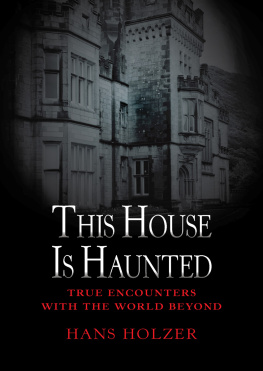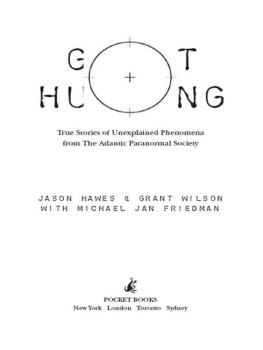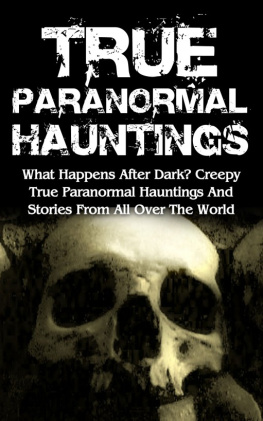

Fall River Press and the distinctive Fall River Press logo
are registered trademarks of Barnes & Noble, Inc.
2006, 1975 by Aspera Ad Astra, Inc.
Cover art Mark Cocks/Millennium Images
Cover design by Jeanne M. Lee
All rights reserved. No part of this publication may be reproduced, stored in a retrieval system, or transmitted, in any form or by any means, electronic, mechanical, photocopying, recording, or otherwise, without prior written permission from the publisher.
ISBN 978-1-4351-4137-7 (e-book)
1 3 5 7 9 10 8 6 4 2
For information about custom editions, special sales, and premium and corporate purchases, please contact Sterling Special Sales at 800-805-5489 or specialsales@sterlingpublishing.com
www.sterlingpublishing.com

 ought to explain what ghosts are, even if you have read one of my previous books or have a ghost of your own perhaps. In my view, ghosts are the surviving emotional memories of people who have died tragically and are unaware of their own passing. A ghost is a split-off part of the personality remaining behind in the atmosphere of their previous existence, whether a home or place of work, but closely tied to the spot where their death occurred.
ought to explain what ghosts are, even if you have read one of my previous books or have a ghost of your own perhaps. In my view, ghosts are the surviving emotional memories of people who have died tragically and are unaware of their own passing. A ghost is a split-off part of the personality remaining behind in the atmosphere of their previous existence, whether a home or place of work, but closely tied to the spot where their death occurred.
Ghosts do not travel, they do not follow people around, and rarely leave the immediate vicinity of their own tragedy. Once in awhile, ghosts roam a house from top to bottom, or may be observed in the garden or adjacent field. But they do not get on cars or buses, they do not appear at the other end of town: those are free spirits, able to reason for themselves and to attempt communication with the living.
In the mind of the casual observer, of course, ghosts and spirits are the same thing. Not so to the trained parapsychologist: ghosts are similar to psychotic human beings, incapable of reasoning for themselves or taking much action. Spirits, on the other hand, are the surviving personalities of all of us who pass through the door of death in a reasonably normal fashion. A spirit is capable of continuing a full existence in the next dimension, to think, reason, feel and act, while his unfortunate colleague, the ghost, could do none of those things. All he can do is repeat the final moments of his passing, the unfinished business, as it were, over and over until it becomes an obsession. In this benighted state he is incapable of much action and ghosts are therefore usually harmless. In the handful of cases where ghosts seem to have caused people to suffer, there was a relationship between the person and the ghost. In one case, someone slept in a bed in which someone else had been murdered and was mistaken, by the murderer, for the same individual. In another case, the murderer returned to the scene of his crime and was attacked by the person he had killed. But by and large ghosts do not attack peoplethere is little danger in observing them or having contact with them, if one is able to.
The majority of ghostly manifestations draw upon energy from the living to be able to penetrate our three-dimensional world. Other manifestations are subjective, especially where the receiver is psychic. In that case, the psychic person hears or sees the departed individual in his minds eye only, while others cannot so observe it.
Where an objective manifestation takes place, and everyone present is capable of hearing or seeing it, energy drawn from the living is used by the entity to cause certain phenomena, such as an apparition, a voice phenomenon, or perhaps the movement of objects, the recreation of footsteps or doors opening by themselves, and other signs of a presence. When the manifestations become physical in nature and are capable of being observed by several individuals or recorded by machines, they are called Poltergeist phenomena, or noisy phenomena. Not every ghostly manifestation leads to that stage, but many do.
Ghosts, that is individuals unaware of their own passing or incapable of accepting the transition because of unfinished business, will generally make themselves known to living people at infrequent intervals. There is no sure way of knowing when or why some individuals make a post-mortem appearance and others do not. It seems to depend on the intensity of feeling, the residue of unresolved problems, which they have within their system at the time of death. Consequently, not everyone dying a violent death becomes a ghost; far from it.
A common misconception concerning ghosts is that they appear only at midnight, or, at any rate, only at night; or that they eventually fade away as time goes on. To begin with, ghosts are split-off parts of personality incapable of realizing the difference between day and night. They are always in residence, so to speak, and can be contacted by properly equipped mediums at all times. They may put in an appearance only at certain hours of the day or night, depending upon the atmosphere; for the fewer physical disturbances there are, the easier it is for them to communicate themselves to the outer world. They are dimly aware that there is something out there different from themselves, but their diminished reality does not permit them to fully grasp the situation. Consequently, a quiet moment, such as is more likely to be found at night than in the daytime, is the period when the majority of sightings are reported.
Some manifestations occur on the exact moment of the anniversary, because at that time the memory of the unhappy event is strongest. But that does not mean that the presence is absent at other timesmerely less capable of manifestations. Since ghosts are not only expressions of human personality left behind in the physical atmosphere but no longer part of it, but are, in terms of physical science, electromagnetic fields uniquely impressed by the personality and memories of the departed one, they represent a certain energy imprint in the atmosphere and, as such, cannot simply fade into nothingness. Professor Albert Einstein has demonstrated that energy can never dissipate, only transmute into other forms. Ghosts do not fade away over the centuries; they are present for all eternity, so to say, unless someone makes contact with them through a trance medium and brings reality to them, allowing them to understand their predicament and thus free themselves from their self-imposed prison. The moment the mirror of truth is held up to a ghost, and he or she realizes that the problems they feel are insoluble are no longer important, they will be able to leave.
Frequently, the rescuer has to explain that the only way they can leave is by calling out to someone close to them in lifea loved one, or a friend, who will then come and take them away with them into the next stage of existence, where they should have gone long before. This is called the rescue circle and a rather delicate operation calling for the services of a trained psychical researcher and a good trance medium. Amateurs are warned not to attempt it, especially not when theyre alone.
The cases in this book are from my files, which bulge with interesting experiences by ordinary people in all walks of life, and from all corners of the globe. The majority of the witnesses knew nothing about ghosts, nor did they seek out such phenomena. When they had the experiences described in these pages, they were taken by surprise; sometimes shocked, sometimes worried. They came to me for advice, because they could not obtain satisfactory counsel from ordinary sources, such as psychologists, psychiatrists, or their minister.
Next page
















 ought to explain what ghosts are, even if you have read one of my previous books or have a ghost of your own perhaps. In my view, ghosts are the surviving emotional memories of people who have died tragically and are unaware of their own passing. A ghost is a split-off part of the personality remaining behind in the atmosphere of their previous existence, whether a home or place of work, but closely tied to the spot where their death occurred.
ought to explain what ghosts are, even if you have read one of my previous books or have a ghost of your own perhaps. In my view, ghosts are the surviving emotional memories of people who have died tragically and are unaware of their own passing. A ghost is a split-off part of the personality remaining behind in the atmosphere of their previous existence, whether a home or place of work, but closely tied to the spot where their death occurred.